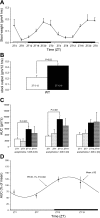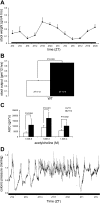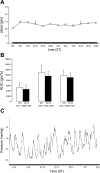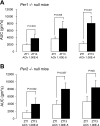Rhythmic changes in colonic motility are regulated by period genes
- PMID: 19926812
- PMCID: PMC2822504
- DOI: 10.1152/ajpgi.00402.2009
Rhythmic changes in colonic motility are regulated by period genes
Abstract
Human bowel movements usually occur during the day and seldom during the night, suggesting a role for a biological clock in the regulation of colonic motility. Research has unveiled molecular and physiological mechanisms for biological clock function in the brain; less is known about peripheral rhythmicity. This study aimed to determine whether clock genes such as period 1 (per1) and period2 (per2) modulate rhythmic changes in colonic motility. Organ bath studies, intracolonic pressure measurements, and stool studies were used to examine measures of colonic motility in wild-type and per1per2 double-knockout mice. To further examine the mechanism underlying rhythmic changes in circular muscle contractility, additional studies were completed in neuronal nitric oxide synthase (nNOS) knockout mice. Intracolonic pressure changes and stool output in vivo, and colonic circular muscle contractility ex vivo, are rhythmic with greatest activity at the start of night in nocturnal wild-type mice. In contrast, rhythmicity in these measures was absent in per1per2 double-knockout mice. Rhythmicity was also abolished in colonic circular muscle contractility of wild-type mice in the presence of N(omega)-nitro-L-arginine methyl ester and in nNOS knockout mice. These findings suggest that rhythms in colonic motility are regulated by both clock genes and a nNOS-mediated inhibitory process and suggest a connection between these two mechanisms.
Figures






Similar articles
-
Role of clock genes in gastrointestinal motility.Am J Physiol Gastrointest Liver Physiol. 2010 Sep;299(3):G549-55. doi: 10.1152/ajpgi.00147.2010. Epub 2010 Jun 17. Am J Physiol Gastrointest Liver Physiol. 2010. PMID: 20558764 Free PMC article. Review.
-
The circadian clock regulates the diurnal levels of microbial short-chain fatty acids and their rhythmic effects on colon contractility in mice.Acta Physiol (Oxf). 2019 Mar;225(3):e13193. doi: 10.1111/apha.13193. Epub 2018 Oct 22. Acta Physiol (Oxf). 2019. PMID: 30269420
-
The mechanisms underlying the generation of the colonic migrating motor complex in both wild-type and nNOS knockout mice.Am J Physiol Gastrointest Liver Physiol. 2010 Feb;298(2):G222-32. doi: 10.1152/ajpgi.00399.2009. Epub 2009 Dec 3. Am J Physiol Gastrointest Liver Physiol. 2010. PMID: 19959818 Free PMC article.
-
An enteric occult reflex underlies accommodation and slow transit in the distal large bowel.Gastroenterology. 2007 May;132(5):1912-24. doi: 10.1053/j.gastro.2007.02.047. Epub 2007 Feb 23. Gastroenterology. 2007. PMID: 17484884
-
Physiology and pathophysiology of colonic motor activity (1).Dig Dis Sci. 1991 Jun;36(6):827-62. doi: 10.1007/BF01311244. Dig Dis Sci. 1991. PMID: 1674470 Review. No abstract available.
Cited by
-
Impaired propulsive motility in the distal but not proximal colon of BK channel β1-subunit knockout mice.Neurogastroenterol Motil. 2012 Sep;24(9):e450-9. doi: 10.1111/j.1365-2982.2012.01981.x. Epub 2012 Jul 26. Neurogastroenterol Motil. 2012. PMID: 22830588 Free PMC article.
-
PI3K-PTEN dysregulation leads to mTOR-driven upregulation of the core clock gene BMAL1 in normal and malignant epithelial cells.Oncotarget. 2016 Jul 5;7(27):42393-42407. doi: 10.18632/oncotarget.9877. Oncotarget. 2016. PMID: 27285754 Free PMC article.
-
Circadian rhythms, alcohol and gut interactions.Alcohol. 2015 Jun;49(4):389-98. doi: 10.1016/j.alcohol.2014.07.021. Epub 2014 Nov 14. Alcohol. 2015. PMID: 25499101 Free PMC article. Review.
-
Brief Disruption of Circadian Rhythms Alters Intestinal Barrier Integrity and Modulates DSS-Induced Colitis Severity in Mice.Inflammation. 2025 Aug;48(4):1900-1911. doi: 10.1007/s10753-024-02162-8. Epub 2024 Oct 16. Inflammation. 2025. PMID: 39407037
-
PER1 modulates SGLT1 transcription in vitro independent of E-box status.Dig Dis Sci. 2012 Jun;57(6):1525-36. doi: 10.1007/s10620-012-2166-8. Epub 2012 Apr 22. Dig Dis Sci. 2012. PMID: 22526585 Free PMC article.
References
-
- Bae K, Jin X, Maywood ES, Hastings MH, Reppert SM, Weaver DR. Differential functions of mPer1, mPer2, and mPer3 in the SCN circadian clock. Neuron 30: 525–536, 2001 - PubMed
-
- Caruso CC, Lusk SL, Gillespie BW. Relationship of work schedules to gastrointestinal diagnoses, symptoms, and medication use in auto factory workers. Am J Ind Med 46: 586–598, 2004 - PubMed
-
- Cassone VM, Stephan FK. Central and peripheral regulation of feeding and nutrition by the mammalian circadian clock: implications for nutrition during manned space flight. Nutrition 18: 814–819, 2002 - PubMed
Publication types
MeSH terms
Substances
Grants and funding
LinkOut - more resources
Full Text Sources
Molecular Biology Databases

